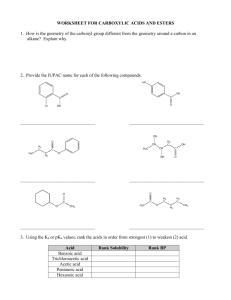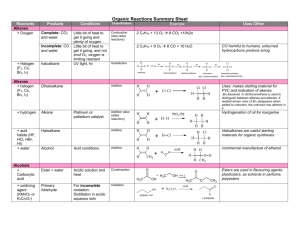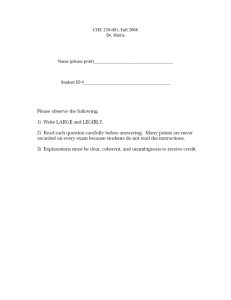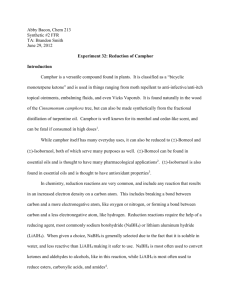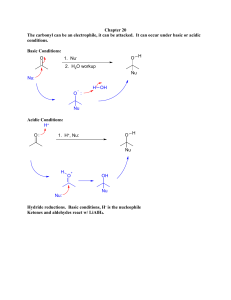Chemistry 238 Chemistry 238 - TAMU
advertisement
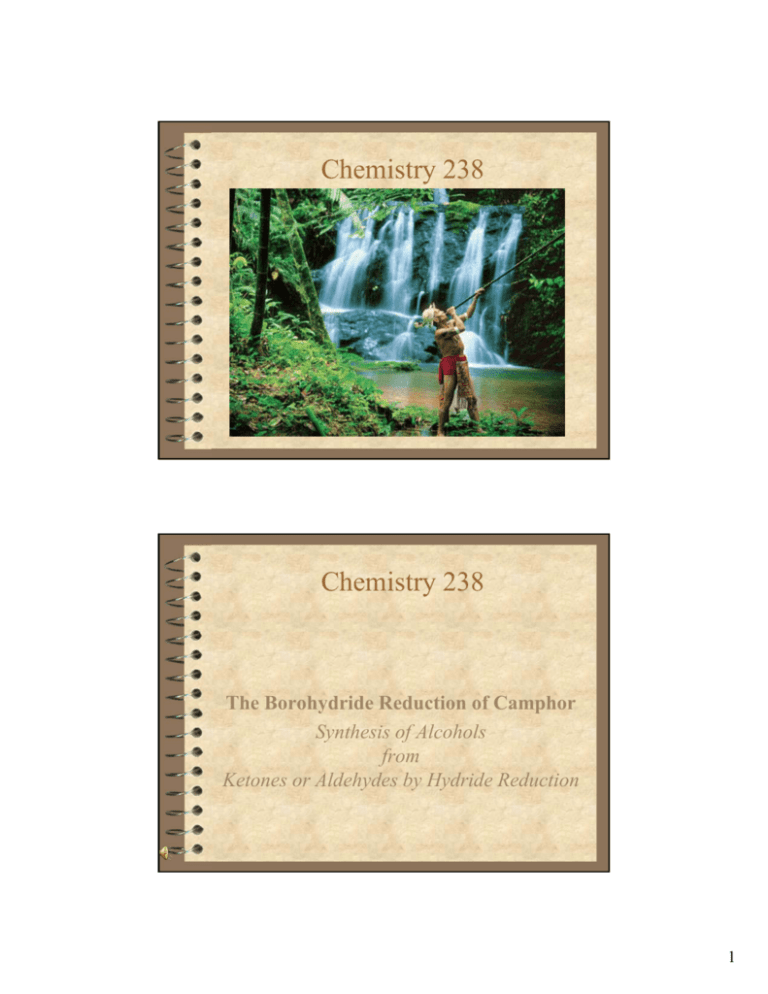
Chemistry 238 Survivor – Borneo! Chemistry 238 The Borohydride Reduction of Camphor Synthesis of Alcohols from Ketones or Aldehydes by Hydride Reduction 1 Objectives 1. To perform the reduction of a carbonyl compound (camphor, a ketone) to an alcohol using a borohydride reducing reagent. 2. To examine the reduction product from camphor using solid-state IR analysis to determine which stereoisomer predominates. 3. To determine if significant amounts of camphor remain in the product. Reduction of Organic Compounds Reduction in general chemistry is defined as the gain of electrons by an atom; this generally leads to a change in atomic charge. Reduction in organic compounds is defined as “increasing electron density on carbon” by forming C-H bonds or by breaking C-Y bonds where Y is more electronegative than carbon. 2 Reduction of Organic Compounds Examples include catalytic hydrogenation and carbonyl reduction. H3C H3C CH3 H2 PtO2 CH2 H3C H CH3 H3C CH3 O CH3 1) NaBH4 2) H3O+ CH3 H OH Reduction of Carbonyl Compounds The reduction of a carbonyl involves addition of the elements of H2, just as in the hydrogenation of an alkene. However, C=O bonds are much less reactive than C=C bonds to catalytic hydrogenation with gaseous H2; therefore the addition of H-H is carried out differently. 3 Reduction of Carbonyl Compounds H2 could be added as 2 H , or as 2 e- and 2 H+, or as H:- and H+. Metal hydrides are reagents which transfer hydride ion, H:-, to other compounds. The two most useful metal hydrides involve the metals boron and aluminum. Metal Hydrides Boron and aluminum are group III metals which can form four bonds with hydrogen, generating a negatively charged ion. H H B H H H H Al H H 4 Metal Hydrides The most common laboratory hydride reagents are: Sodium borohydride, NaBH4 Lithium aluminum hydride, LiAlH4 Lithium aluminum hydride is a more powerful reagent, but more difficult to use because of its high reactivity with moisture, water, and protic solvents. Metal Hydrides Sodium borohydride, NaBH4, is sufficiently reactive to reduce aldehydes or ketones. However, reduction of carboxylic acid or ester functional groups requires the more reactive lithium aluminum hydride, LiAlH4, as reagent. You will be using sodium borohydride in the laboratory today. 5 Sodium Borohydride, NaBH4 OH O 1) NaBH4, CH3CH2OH R CH 2) H3O C 1o CH2 OH O R R + 1) NaBH4, CH3CH2OH R' R 2) H3O+ C H R' 2o Aldehydes are reduced to primary alcohols, and ketones are reduced to secondary alcohols. Protic solvents such as ethanol or even water can be used. Lithium Aluminum Hydride, LiAlH4 O OH 1) LiAlH4, THF R CH + 2) H3O C 1o CH2 OH O R R 1) LiAlH4, THF R' 2) H3O+ R C H R' 2o LiAlH4 will also reduce aldehydes and ketones to alcohols. However, scrupulously dry non-protic solvents must be used because of its reactivity with water. 6 Lithium Aluminum Hydride, LiAlH4 O 1) LiAlH4, THF R C OH O R C R 2) H3O+ 1) LiAlH4, THF OR' 2) H3O+ R CH2 OH 1o CH2 OH + HOR' LiAlH4 is also strong enough to reduce esters and carboxylic acids to alcohols. Excess hydride reagent must be used in these cases. Reduction of Cyclohexanone Cyclohexanone is reduced by sodium borohydride into cyclohexanol. Although hydride could be transferred to the ketone group from either top or bottom of the ring, the same product, cyclohexanol, is formed from both pathways because there are no stereoisomers possible. top H O + H B H3O+ OH H H bottom H single product 7 Reduction of Camphor Two naturally occurring monoterpenes CH3 H3C H3C O camphor limonene Reduction of Camphor The cyclohexanone ring of camphor is held in a rigid boat conformation by the bicyclic ring skeleton. The concave (bottom) side of the ring is called the endo face. CH3 H3C H3C top (exo) O O bottom (endo) 8 Reduction of Camphor Attack of hydride from the endo face gives an alcohol with the OH on the exo face. This is called the exo isomer and is named isoborneol. CH3 H3C CH3 H3C H + H3C H O B H H3O+ OH exo H3C H endo attack H isoborneol Reduction of Camphor Attack of hydride from the exo face gives an alcohol with the OH on the endo face. This is called the endo isomer and is named borneol. CH3 H3C H exo attack + H3C CH3 H3C O H B H H H3O+ H H3C OH endo borneol 9 Reduction of Camphor In camphor, endo attack is hindered by the hydrogens on the boat cyclohexane ring. However, the exo attack from the top is hindered by the methyl group sticking out over that face. steric hindrance Determining the major product from your CH3 top (exo) H3C reaction allows you to determine which of these two factors is more important! CH3 O H H bottom (endo) IR Identification of major product The IR spectra of borneol and isoborneol are very similar in the functional group region. However, there are differences in the fingerprint region of the spectrum (below 1500 cm-1) that can be used to determine which product is the major product. You will also be able to determine if significant amounts of camphor remain in your product by examination of the C=O stretch region of the spectrum. 10 Comments on procedure You will use ethanol as your reaction solvent. This will react slowly with sodium borohydride, so we use an excess of hydride reagent. After you add your sodium borohydride reagent, allow the reaction to stand for 10 minutes, before you heat the reaction on the steambath. This is a change from the lab manual. Comments on procedure You will heat the reaction to boiling on a steambath. What is the boiling point of ethanol? (It should be on your pre-lab page!) After you pour your reaction into ice water, you need to let all ice melt before you filter. Break up clumps of solid in the beaker to make sure all borate esters are cleaved. 11 Comments on procedure Recrystallize the crude product from an ethanol/water mixture. (See recrystallization techniques section in lab manual, p. 35.) Dissolve the product in minimal amount of hot ethanol, then add water slowly until it clouds up. Warm again until everything is in solution and allow to cool slowly. Air dry the crystals by pulling air through the Buchner funnel for several minutes. Comments on procedure You then should transfer all of your crystals onto a clean piece of 15-cm filter paper. Fold the paper into an enclosing packet, tape with purple tape, label with your name, and store the crystals until next week. Next week, you will need to weigh your product, obtain an IR spectrum, and take a melting point of your product. 12 Product Analysis You must compare your IR spectrum to the posted spectra of pure camphor, borneol, and isoborneol in order to determine the predominant product obtained. IR of solids In Chem 237, you used the IR instruments to obtain spectra of liquid samples. The procedures are different for solids. Student workers will lead you through the procedures. The major difference is that solid products placed on the diamond crystal do not make good contact with the face of the crystal. 13 IR of Solids Therefore, we use the pressure arm to press the solid onto the crystal face. The instrument will beep when you have exceeded the necessary pressure. Cleaning the diamond crystal after taking spectra is also different. We will use acetone as a solvent to help remove the solid sample. Wet a cotton ball with acetone and use it to clean the crystal. AVOID excess acetone. Which isomer do you have? Major differences between the two isomers can be seen in the 1000 – 1100 cm-1 region of the IR spectra. Also check the 1700 cm-1 region for presence of camphor. 14 Safety The sodium borohydride reagent is a fine powder (when dry!) which is hygroscopic – that means it absorbs moisture from the air. Keep the bottle tightly closed when it is not being used!! Reaction with water gives sodium borate and H2 gas. Sodium borohydride is corrosive and damaging to skin and eyes. Handle with care and wash exposed skin immediately. Safety Camphor and isoborneol are classified as irritants and are also flammable. Read the Safety box in the the lab manual before starting lab. 15 Clean-up Dispose of filter papers and product in the appropriate waste bottles. Solvents from filtration go into the “aqueous” waste bottles in hood. DO NOT put lids on these waste bottles. Workstations and Partners Workstation # - Check latest Roster Partners are #1 & #2, #3 & #4, etc. You will work with your partner on one reaction set-up today. Only odd # bins have a glassware set-up. If your partner is absent, have your TA check with Room 2202 about the possibility of a partner in another lab room. Each of you must record data from the experiment in your laboratory notebook. 16


